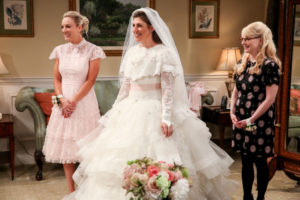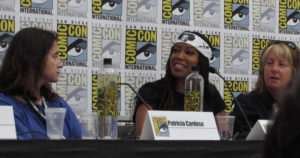SDCC 2018: Women in Hollywood, Location Managers, Superhero Composers, Top Sitcoms, and A Motion-Capture Monster
Posted on July 29, 2018 at 8:00 am
Some of what I saw at San Diego Comic-Con 2018, with excerpts from my coverage at Rogerebert.com and Thecredits.org:
Behind the scenes of The Big Bang Theory, The Good Place, and Crazy Ex-Girlfriend.

Though it was billed as a panel of “The Big Bang Theory” writers, two of the stars showed up, Kunal Nayyar and Mayim Bialik.
Bialik said about the dress Sheldon described on the show as “looking like a pile of swans,” “We wanted Amy to have a dress that embodied all of her dreams and wishes. Why have just one? If she loves it, it’s not going to look silly.” Nayyar was not impressed with her description of the difficulties of the hoop skirt. “Did you have to ride a seahorse as Aquaman?”
On “The Good Place,”
Kristen Bell (Eleanor) envies her character’s forthright snark. “Eleanor is the ticker tape in my head of nasty, sassy things, not necessarily that I want to say, but I’m definitely thinking about anyone that I see. I don’t find that I get good results in real life when I say that, and I’m looking for good results, guys. I’m looking for smiles and happiness. And so I don’t say them but I do share that wicked, dark sensibility with Eleanor.”
They found Jumanji in Hawaii, Skull Island in Vietnam, Hogwarts in England, and Wakanda in South Africa. The script calls for a 1970’s gas station or a Jane Austen-era house of an earl or the topography of another planet? Location scouts are the visual artists and logistical wizards who find the places that you see on the screen and oversee all of the details to make sure the crew has what they need and that, like Boy Scouts, they leave the place better than they found it. A panel of location managers talked about finding a way for three helicopters to land in London’s Trafalgar Square. Their job is to take the creative vision of the writer, director, and production designer and “turn it into reality. We give them options, narrow it down, and then handle all of the permits, trashcans, port-a-potties, places to prepare and serve food, and parking spaces” for a crew that could include hundreds of people and all of their equipment. “It’s kind of like a moving circus.” They have to coordinate with local police and fire crews and make sure the area is safe for the cast and crew. “And most important,” he said, “is preservation. We leave it the way it was, if not better.” Sometimes pre-production schedules are so long that they come on board before the director, and just do the best they can, based on the script, preparing a number of options to present when the director is selected.
Composers talked about creating music for superheroes to save the world by.
Christophe Beck composed the music for the “Ant-Man” movies, matching the tone of the movie’s visuals and storyline. “It had to be quirky and off-beat but still making sure it was in the Marvel universe.” He explained that most popular music is in four beats to the bar, but he created this score in 7/8. “There’s like an extra beat in every bar.” For the Wasp character, he did five beats to the bar “to give her forward movement and great energy.” He found himself creating “a darker version of the theme” that was not right for the film but matched the end credit sequence.
I saw two panels of women working in Hollywood.

There was some good news at Leslie Combemale’s third annual Women Rocking Hollywood panel at San Diego Comic-Con. Women in Film LA director Kirsten Schaffer told the packed room that in the era of #MeToo and inclusion riders, “every studio and network has a program” to encourage and support women at every level of film production. When studios were invited sign up for WIF’s Reframe initiative, which is designed to work inside the system through conversations, resources, and data to assess progress, 35 immediately agreed. WIF is also going to be issuing a gender parity stamp—“think LEED certified or USDA organic—to let the public know which productions are close to 50/50. Their “Flip the Script” series of short films uses humor and empathy to show what women in film productions go through by using actual dialogue but switching the gender of the characters…A panel called “You Do What? Women in Film Production” featured Lauren Haroutunian (cinematographer, “Fangirling”), Alicia Varela (first AC, “Video Game High School”), Lolita Ritmanis (composer, “Batman Beyond”), Sylwia Dudzinska (AD, “You’re the Worst”), and Maritte Go (line producer, “Sleight”) discussing work in traditionally male-dominated fields of production, moderated by publicist Brittany Sandler.
And I really loved talking to Jason Liles about playing a gorilla in “Rampage” and two monsters in the upcoming “Godzilla” movie.

I started studying my butt off, going to the L.A. Zoo just watching gorillas for hours, watching them be still but also watching them be alive in stillness. That’s really key, not just running around but just being. I watched “Planet of the Apes” behind the scenes, “King Kong” behind the scenes and anything with Andy Serkis or Terry Notary. I watched a lot of Koko the gorilla who learned to sign, every bit of footage I could find on her, and tons of documentaries. You just type in “gorilla documentary” on YouTube. It’s incredible the amount of stuff that comes up. So I found what was the most useful for me and just rewatched it and studied it.
Then I got brought on to the film and trained with Terry Notary who is King Kong and Kong in “Kong: Skull Island” and Rocket in “Planet of the Apes.” He’s done so many characters and coached some incredible performances out of actors. He trained me for three weeks in the Santa Monica mountains on all fours, hundreds of hours of miles with these arm extensions, learning to engage my senses as a gorilla and strip down what makes me Jason and a man and an American and a human and just be an ape. So it was a huge process. He got it to where I could basically lucid dream while awake as a gorilla. I can’t even describe it; I felt like I could fly at some moments. It was crazy.
